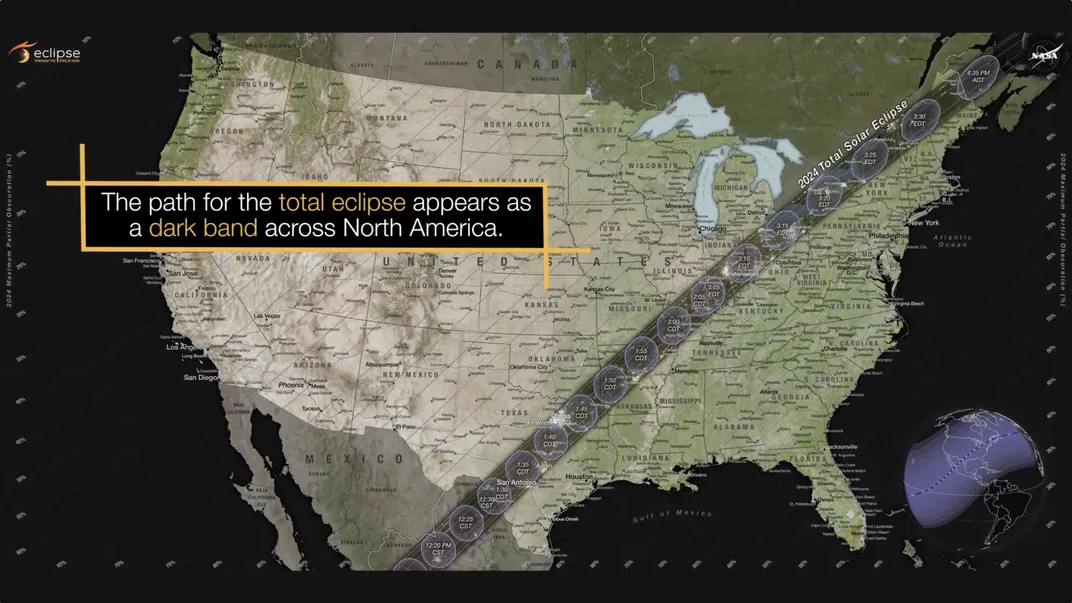You Can Watch the Solar Eclipse From These Flights Through the Path of Totality
Delta Air Lines and Southwest Airlines are operating flights on April 8 that could give passengers unobstructed views of the rare celestial spectacle
:focal(640x405:641x406)/https://tf-cmsv2-smithsonianmag-media.s3.amazonaws.com/filer_public/22/d3/22d31b31-0fa6-429d-9222-80d797a6ab07/aircraft-1362586_1280.jpg)
Still making plans to see the total solar eclipse on April 8? Instead of watching the rare celestial spectacle from the ground, you might consider viewing it from the air: Some airlines are offering flights that will soar through the eclipse’s path of totality, giving travelers an unobstructed view of the highly anticipated event.
This week, Delta became the latest airline to announce a special total solar eclipse itinerary. Flight 1218 will depart from Austin at 12:15 p.m. Central time and land in Detroit at 4:20 p.m. Eastern time—a timeline and route that aligns with the path of the moon’s shadow over the United States.
The airline says it’s offering the flight on an A220-300 aircraft, because the plane has extra-large windows, perfect for viewing the eclipse.
“Thanks to teams across the company, the idea of viewing a total eclipse from the air will become a reality for our customers,” says Eric Beck, the airline’s managing director of domestic network planning, in a statement.
Travelers who can’t make Delta’s flight 1218 have several other options for watching the eclipse from the air. At least five regularly scheduled Delta flights could also offer views of the moon passing in front of the sun, with departures from Detroit, Los Angeles and Salt Lake City.
Southwest Airlines also has multiple flights operating on April 8 that will likely offer views of the eclipse, with departures from Dallas, Austin, St. Louis, Milwaukee, Houston, Chicago and Nashville.
And at least two private jets are scheduled to chase the eclipse as it moves across the sky: T.E.I Tours & Travel is organizing special “Umbracept” experiences aboard two Cessna Citation X jets that will depart from Kerrville, Texas, fly over Mexico, then return to Texas roughly three hours later. For the price of $9,750 per person, passengers could experience 6 minutes and 50 seconds of totality from the planes—longer than anywhere on the ground.
One big reason to experience the eclipse from a plane? Clouds. Most commercial planes fly between 30,000 and 42,000 feet above the ground, which means passengers will likely be above any clouds and should have a clear view of the eclipse. From the ground, clouds could obscure the view—and the odds of clear skies in the U.S. and Canada on that day are only about 50/50, reports Forbes’ Jamie Carter.
“April is a month that struggles to get out from under the clouds as winter reluctantly gives way to spring,” writes Jay Anderson in Astronomy magazine.
Clouds or no clouds, the airlines do not guarantee that passengers will be able to see the eclipse from their planes. Weather and other delays could always disrupt flight schedules and routes on April 8, meaning travelers might miss some or all of the event.
“While Delta flight plans have been designed to maximize time within the path of totality, this is subject to change due to factors outside of Delta’s control, such as weather and air traffic control, that could impact timing and aircraft,” according to Delta’s statement.
Several cruise lines are also offering special eclipse sailings. But for any eclipse-chasing umbraphiles who want to stay on land, the best places to travel are within the path of totality, which will include parts of Texas, Oklahoma, Arkansas, Missouri, Illinois, Kentucky, Indiana, Ohio, Pennsylvania, New York, Vermont, New Hampshire and Maine, as well as parts of Mexico and Canada. The April path of totality is home to an estimated 31.6 million U.S. residents, which is much larger than the 12 million residents who lived within the path of totality during the August 2017 total solar eclipse.
Wherever and however you end up watching the spectacle—whether in an airplane, on a cruise ship or on the ground—you’ll need to wear eclipse glasses to protect your eyes. Cameras also need special solar filters to safely photograph the eclipse.
/https://tf-cmsv2-smithsonianmag-media.s3.amazonaws.com/accounts/headshot/SarahKuta.png)


/https://tf-cmsv2-smithsonianmag-media.s3.amazonaws.com/accounts/headshot/SarahKuta.png)